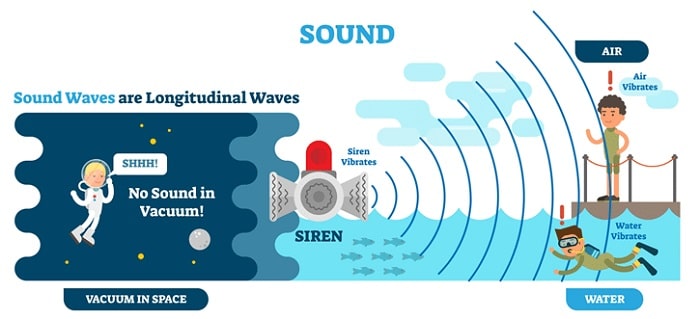
Table of Contents
ToggleUnderstanding the Basics of Sound

To understand why sound cannot travel through certain mediums, it’s essential to know what sound actually is. In its simplest form, sound is a type of energy made by vibrations. These vibrations create pressure waves that move through various mediums, such as air, water, or solids, allowing us to hear sounds when they reach our ears.
What Exactly Are Sound Waves?
Sound waves are mechanical waves, meaning they require a medium to move through. Mechanical waves differ from electromagnetic waves, like light, which can travel through a vacuum. In sound waves, particles in the medium (like air molecules) oscillate back and forth, creating areas of compression and rarefaction.
How Does Sound Travel?
Sound travels when an object vibrates, causing nearby particles to move. This movement creates waves of high and low pressure, which travel through the medium. Let’s look more closely at how this works in different mediums:
- Air: The most common medium for sound travel. Sound waves travel well in air because of the space between particles, allowing vibrations to propagate easily.
- Liquids: Sound travels faster in liquids than in air because particles are closer together, making it easier for vibrations to pass through.
- Solids: Sound travels fastest in solids since particles are densely packed, providing an efficient pathway for energy transfer.
The Role of Mediums in Sound Transmission
The type of medium plays a significant role in how fast and how far sound can travel. Sound needs a medium because it relies on particle interactions to propagate. The properties of a medium, like density and elasticity, determine sound’s speed and clarity.
Why Sound Cannot Exist Without a Medium
If there is no medium for the vibrations to travel through, sound waves have no particles to carry their energy. This is why, in a vacuum, sound waves cannot propagate.
Why Sound Cannot Travel Through a Vacuum
A vacuum is a space entirely devoid of matter, meaning there are no particles—solid, liquid, or gas—for sound waves to use as a carrier. Since sound is a mechanical wave, it requires these particles to move through. This is the same reason why outer space is completely silent.
The Science Behind Sound in a Vacuum
In a vacuum, the absence of matter makes it impossible for sound waves to initiate the chain reaction necessary for their transmission. Experiments in physics have consistently demonstrated this: sound cannot travel through a vacuum because there’s simply nothing for the wave to vibrate.
The Myth of “Sound in Space”
Popular science fiction often portrays sound in outer space, such as spaceships exploding with a roar. In reality, explosions in space would be silent, as the lack of air or any other medium would prevent sound waves from traveling to an observer.
Also Read: Radhika Merchant’s Father’s Business
Why Certain Solid Materials Block Sound
While sound travels best in solid materials, not all solids allow sound to pass through easily. Dense materials with particular structures can dampen or completely block sound waves. Sound-blocking materials are useful in soundproofing and acoustics applications, where controlling sound is necessary.
Characteristics of Sound-Blocking Solids

Sound-blocking materials, like dense concrete or lead, are designed to absorb or reflect sound waves rather than transmit them. The denser the material, the harder it is for sound to pass through.
- Density and Thickness: Thick, dense materials make it difficult for sound waves to penetrate, which is why concrete walls often serve as good sound barriers.
- Porous vs. Non-Porous Solids: Materials with pores (like foam) absorb sound waves, making them good for sound insulation.
Real-World Examples: Where Sound Does and Doesn’t Travel
Understanding where sound can and cannot travel is crucial in many industries, from construction to acoustics.
Soundproof Rooms
Soundproof rooms, such as recording studios, use materials that limit the travel of sound. These rooms are often built with multiple layers of sound-blocking materials, ensuring that outside noise cannot enter, and inside noise doesn’t escape.
Submarine Communication
In water, sound travels well, which is why submarines rely on sonar (Sound Navigation and Ranging) for underwater communication. However, if a submarine enters a bubble-filled area, communication can be interrupted as air pockets disrupt sound waves.
Vacuum Chambers in Research
In scientific experiments, vacuum chambers are used to study phenomena without interference from sound or other disturbances. These chambers simulate space-like conditions, emphasizing that no sound can travel in these controlled vacuums.
Applications of Soundproofing and Insulation
Soundproofing technology relies on understanding how sound interacts with various materials. Industries use this knowledge for practical applications, from creating silent work environments to enhancing privacy in public buildings.
Common Soundproofing Techniques
- Mass-Loaded Barriers: Dense materials, such as heavy blankets or mass-loaded vinyl, are used to create barriers that block sound from passing through walls.
- Decoupling: Walls can be built with air gaps to prevent vibrations from moving directly from one side to the other, effectively insulating the sound.
- Absorption Materials: Acoustic panels, often seen in recording studios, absorb sound energy, reducing echoes and noise within a room.
Soundproofing in Architecture and Urban Planning
Soundproofing is becoming more common in urban planning, where noise pollution from transportation and construction impacts daily life. City buildings are now designed with noise reduction in mind, incorporating sound-absorbing walls and windows to make indoor spaces quieter.
The Boundaries of Sound Travel
Understanding why sound cannot travel through certain environments or materials helps us appreciate the science behind what we hear and what we don’t. Sound requires a medium, and without particles to propagate its waves, sound simply cannot exist. This phenomenon is a fascinating aspect of physics, shedding light on the vast, silent stretches of outer space and enabling us to manipulate sound on Earth.
In an age where noise pollution is a growing concern, this knowledge also aids in developing technologies to control and manage sound effectively, improving the quality of life in densely populated environments. Whether we’re trying to communicate across oceans, design quiet living spaces, or simply understand the silence of space, the limitations of sound travel shape our experiences and our environment.




